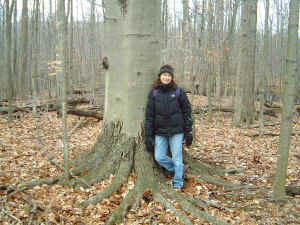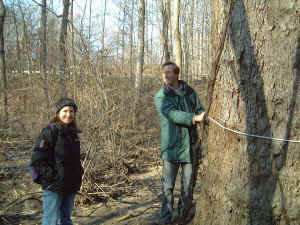| Haven
Hill and Warren Woods, MI |
doug
bidlack |
| Jan
05, 2007 21:40 PST |
ENTS,
Highland State Recreation Area is a 5,534 acre park in
western Oakland County, Michigan. Nearly 700 acres of
this park is known as the Haven Hill Natural Area. It
is supposed to contain every forest type found in
southern Michigan. In the past I had found some small
chestnut trees as well as some trees that I had
identified as swamp cottonwoods
basswood. This is the first
and, to date, only place that I have ever seen these
species in Michigan. So it's a special place for me.
It's also only 20 minutes or so from my parent's
house. I wanted to show Ellen, my wife, these trees
during our walk to find big trees. The chestnuts
didn't do much for Ellen, probably because they are so
common in New England (we even have one in our
backyard). She thought the swamp cottonwoods
basswoods
were
cool though, especially the one right at the edge of
the white cedar swamp. This cottonwood
basswood had a nice
buttress which is something you just don't see much in
Michigan trees. In fact, this was the only tree that
I ever saw with a buttress in Michigan. Little did I
know that I would soon see another buttress on a
completely different species. When we searched for
leaves around the swamp cottonwood
basswood we found a few.
What struck me most was their broad rounded form and
especially their fine teeth that were shaped like
little fish hooks. The fine, curved teeth turned out
to be a key characteristic in the Audubon field guide.
Just a few hundred yards farther down the trail,
Ellen looked to her left and saw a tree at the edge of
a vernal pool. "What's that!" We both ran over to
the tree. Wow! What a buttress! But this looks like
an oak. Soon we were looking for leaves and we found
some oak leaves that looked very southern to me.
Between the buttress and the leaves I was thinking
Shumard Oak Bur Oak. Yet another species I had never seen in
Michigan. What a great day! Anyway, we measured the
oak that I thought might be a Shumard
Bur Oak and we measured
the Swamp Cottonwood, even though neither was all that
large. Below are some of our measurements. CBH first
then height.
Northern Red Oak 126" 99'
White Ash 116" 105.5'
Tuliptree 113" 109.5'
White Oak 110" 96'
Bur Oak 109"
Sugar Maple 100"
American Beech 98"
Shumard Oak? 84" 94.5'
Bur Oak 84" 94.5'
Swamp Cottonwood 67" 90.5'
Basswood 67" 90.5'

Shumard Oak? Bur Oak (84" x 94.5') and Ellen.
Haven
Hill. |

Shumard Oak? Bur Oak (84" x 94.5') and Ellen.
Haven
Hill. |

Beech (98" cbh) and Ellen. Haven Hill. |

Location: Haven Hill |
The white ash was dead due to emerald ash borer and
the same was true of all other ashes that we
encountered. We found one tuliptree that was taller,
at 123', but it was very skinny. It just happened to
be growing next to another tuliptree at the edge of a
swamp which sits in a big bowl. So the ground sloped
up and away from the swamp, thereby forcing the
tuliptree to compete with one of its own as well as
other species with a serious headstart. We ended up
finding several other Shumard Oaks? quite distant from
the first ones and some were a good bit larger than
the one we measured. However, they were on higher
ground and did not have buttresses so I was less
certain of their identity. The oak leaves I found
most closely match a drawing of a Cherrybark Oak leaf
in the Peterson field guide on page 143 (figure 22).
Most of the photos and drawings of Shumard Oak leaves
do not match the leaves I found very well. However, I
have seen a couple photos of Shumard Oak leaves that
show the variation within this species and some of
these were a good match for mine.
Two days later we went to Warren Woods in southwestern
Michigan. This is a truly spectacular Beech Forest.
Unfortunately, I didn't have as much time as I would
have liked. For most species I only measured a single
large tree. In particular, I am sure there are larger
Northern Red Oaks and Sugar Maples. I would also like
to add that I am surte that all of the heights are
underestimates as I was just shooting straight up and
at the time I did not know about the scan feature.
I'd be willing to bet that most of these trees are
from 5-15' taller than the numbers I am posting.
Tuliptree 183" 125"
Sycamore 171" 112.5'
American Beech 159" 119'
Eastern Cottonwood 154" 110'
Hackberry 150" 115.5'
White Oak 140" 107'
Northern Red Oak 128"
Sugar Maple 105"

Sycamore (171" x 112.5'), Ellen and Doug.
Warren Woods. |

Location: Warren Woods |
I believe that the tuliptree we measured may challenge
the one that Don measured in Russ Forest as the
biggest in Michigan when it's height can be more
accurately measured.
Doug
|
| Re:
Haven Hill and Warren Woods, MI |
brown_-@colstate.edu |
| Jan
06, 2007 12:41 PST |
Shumard oak shows up as a few outliers in S. Michigan, so its
possible. Years ago a friend of mine (a Paul Smith's grad) were
cutting firewood on the Schuylkill floodplain in N Berks Co PA
and
found some unusual oaks that we keyed out to Shumard. The
Little
Range maps show it as outliers further west in PA but not in
that
area.
Roger Brown
|
| Re:
Haven Hill and Warren Woods, MI |
Jess
Riddle |
| Jan
11, 2007 18:27 PST |
Doug,
Thanks for the trip reports. I always enjoy seeing disjunct tree
populations too. Base on your initial foray, Warren Woulds
should be
impressive for not only the height index but also the
circumference
index.
Jess
|
| Michigan
Shumard Oak |
Doug
Bidlack |
| Jan
30, 2007 22:50 PST |
I have a couple
digital pictures of what I believe is a Shumard Oak
in Haven Hill, Michigan. I'm not sure of the best way to post
these,
though. I also have a picture of a nice Beech at Haven Hill and
a
Sycamore at Warren Woods.
I think I
may have found some Shumard Oaks in Oakland County, MI and I
will send Ed a couple of pictures of one tree tonight. According
to
Barnes and Wagner in their book 'Michigan Trees', Shumard Oak is
known
in MI from Monroe, Wayne, Jackson and Kalamazoo Counties. I
really
don't know this oak very well at all, but only a couple months
before I
saw the Michigan oak that may be a Shumard, I saw a very large
Shumard
Oak in central Indiana. The buttressed trunk really stood out
for me.
|
|